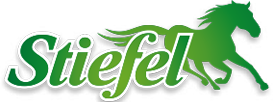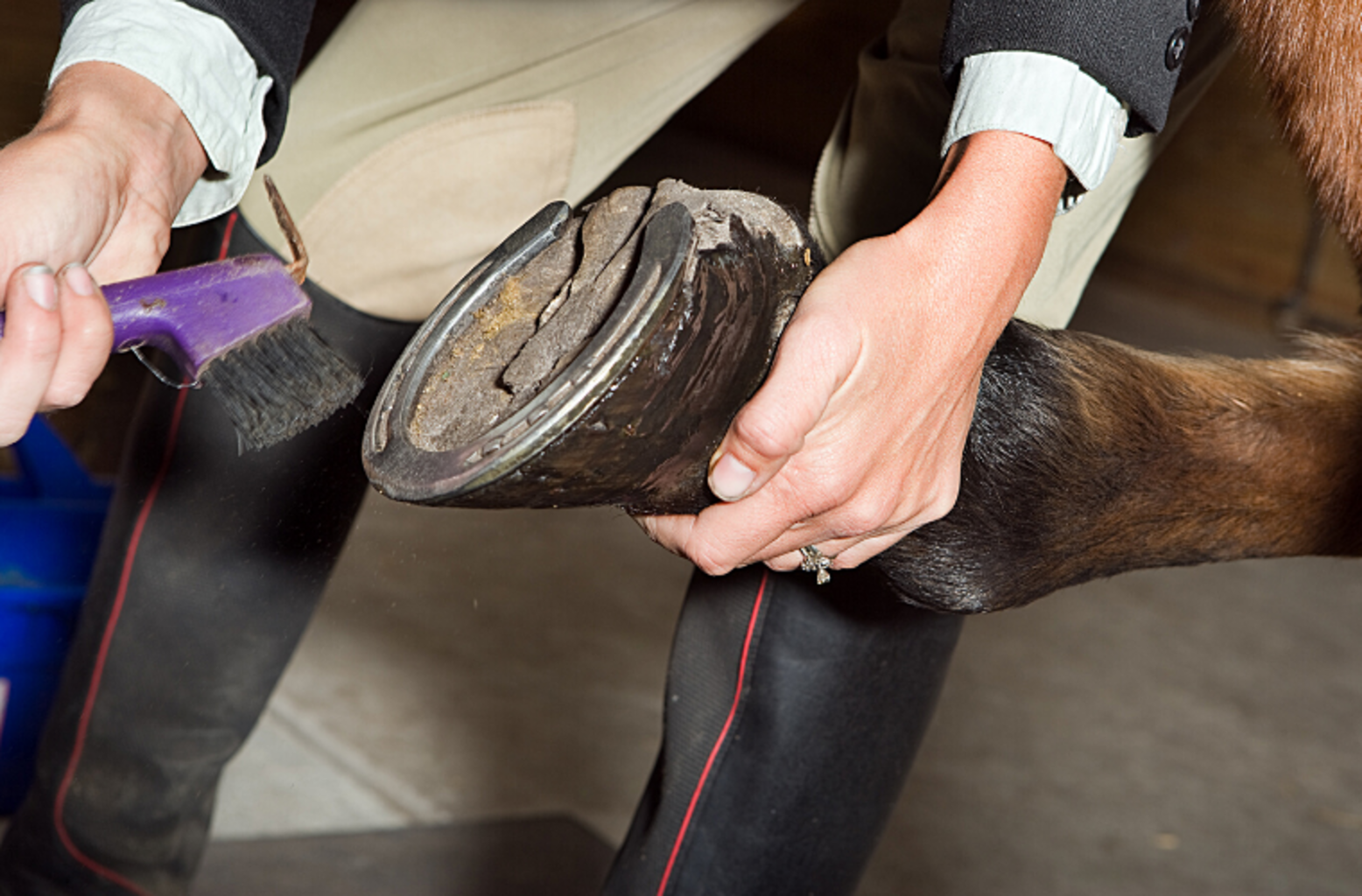Strong hooves
By Amelie Kokorsky
The hoof is an important part of the horse's body. A horse cannot sit down for a long period of time like a human being and the horse also lies down significantly less than a human being. It can be concluded that horses spend most of their lives standing on their hooves. Optimal hoof health therefore determines to a large extent the health and well-being of every horse. In this article, we will focus on the topic of hoof health.
Anatomy of a horse's hoof
Let's start with the rough structure and anatomy of a horse's hoof.
The hoof from the outside:
Above the hoof lies the fetlock. If you travel from the long pastern bone towards the hoof, you will first encounter the pastern and the pastern flexure. Under these structures the hoof begins with the transition from normal skin and coat to the hoof (horn). The coronet forms this transition. After the coronet follows the hoof / the hoof horn.

The bones of the hoof:
The three bones that can be counted among the structures of the hoof are: The coffin bone (os ungulare), which lies deep inside the hoof and the short pastern bone (os coronale) , which is mostly already situated above the hoof. The navicular bone (os sesamoideum distale) lies under the short pastern bone and next to/ behind the coffin bone. The bones of the hoof are still quite simple and straightforward. The structure of the various hoof skins and connective tissue is much more complicated.
Connective tissue and corium of the hoof:
Let's start inside the hoof and work our way out. Inside the hoof lies a thick frog pad. It consists of soft, fibrous connective tissue. Although it is flexible and gives way under stress, it has a firm structure and shape. The frog pad fills the bale pit and forms the familiar frog on the outside, which is clearly visible when the hoof is scraped.
Directly adjacent to the frog pad is the bale pad. It has a similar structure and forms the horse's pads upwards-backwards. This is the tissue that is injured by the hind legs or also by the hooves of other horses during a "typical bale kick". The bale area can therefore be protected by the use of bell boots. Anyone who has ever touched a bale on a horse can better imagine the structure of the tissue. The bale pads can be easily pressed in and give way under the pressure of the finger, but the shape is not changed.
Another pad is the crown pad. As the name suggests, it is located in the area of the navicular bone and the navicular band, further up on the hoof. The crown pad is located in the area of the navicular band, i.e. in the zone where the hoof and the horse's leg merge.
Another structure of the hoof is the corium. Depending on its position and function in the hoof, it can be divided even more precisely. Let's stay with the transition where the horse's leg and hoof merge. This is where the corium is found. This is a very small skin about five millimetres wide. The transition from the normal skin of the horse's leg to the coronal corium of the hoof is formed by the corium. The coronal corium is directly connected to this skin. The coronal corium surrounds the hoof in a ring. Thousands of small villi protrude into the hoof from the coronet corium.
The tendons and ligaments of the hoof:
In addition, of course, some tendons and ligaments run on and in the hoof. The common extensor tendon running from the front of the leg to the hoof is interesting. From the back of the leg pulling forward to the hoof runs the pastern tendon. Also running along the back is the superficial flexor tendon. It runs deep down to the coronet bone. The deep flexor tendon runs even deeper into the hoof. This tendon runs over the navicular bone and is fused with the coffin bone in the hoof.
The hoof from below:
Looking at a hoof from below is a familiar sight to most riders due to the daily scraping of the horse's hooves. If you look at the hoof from below, you first see the hoof capsule. This capsule can be further divided into bale pads, sole, frog and hoof wall. The bale pads are located at the rear, upper end of the hoof and are easy to press in. The tissue is more sensitive and gives way under the pressure of the fingers. The bale pads should not be cleaned with a hoof scraper or care should be taken that only the brush on the hoof scraper is used and that the brush is not too hard. Horses can be very sensitive around the bale pads. The frog of the hoof is directly adjacent to the bale pads. The frog runs from the pads down to the centre of the hoof in a small "V" or triangle. Next to the frog are the hoof furrows, which you clean with a hoof scraper. Do not clean the frog with the hoof scraper either, but only use the (soft) brush side for cleaning. Be especially careful with the soft furrow in the middle of the frog, because this area of the hoof is also still quite sensitive and can respond to too rough touch or pressure with a painful reaction. The rest of the hoof consists of the hard sole. It is enclosed by the so-called "white line" and ends with the outer edge, the hoof wall.

The hoof mechanism
At first glance, a horse's hoof appears very firm and rigid in its movement, but this appearance is deceptive. A hoof can react well to stress/ pressure and even adapt to it in some cases. This reaction is called the hoof mechanism. Every step is perceived by the hoof and triggers a small chain reaction inside. When the horse sets the hoof down, the front edge of the coronet bone is pulled backwards and the bale pads at the back of the hoof are pushed apart. The frog under the hoof comes into contact with the ground and can thus pass on information about the ground via the numerous nerve fibres in the corium. When the hoof breaks away from the ground, the bale pads are pulled together again and a kind of "pump" is created in the hoof.
The hoof is supplied with blood through the active movement of the legs and the constant loading and unloading of the hooves - comparable to a sponge under water lying in one hand: When the hoof touches the ground, the sponge in the hand is compressed and the water is pressed out of the sponge. When the hoof leaves the ground, the hand opens and the sponge can soak up water until the hoof hits the ground again.
The same effect happens in the horse's hoof with the supply of blood. In motion, however, this process cannot be observed on the hoof because the steps are very fast and the tissues only contract and expand minimally. However, it becomes clear how important movement is for the health of the hooves. Without regular exercise (on different soils) the hooves will have poor blood circulation. Even before any athletic exercise, the horse should walk enough at the beginning to activate the hoof mechanism and to provide sufficient blood supply to the hoof with its surrounding structures. Horse hooves are primarily supplied with blood passively through movement and the "pump system" in the hoof.
The foundation of hoof health
The foundation of hoof health is largely laid by the basic feed. Feeding can have a huge impact on hoof health. So before feeding supplements for better horn quality, check the basic feed. Mould-free hay and straw should form the basis of every horse's diet. The quality is important.
As already mentioned, hay and straw should be free of mould. Why? Because mould is a burden on the liver. This stress can also have an indirect negative effect on the hooves. The same applies when feeding silage. In the best case, no horse should be fed silage, because silage also stresses the liver and intestines and can contribute to deteriorating hoof health.
The strain on the liver, stomach and intestines should also be taken into account when administering medication. Regular or prolonged administration of medications such as cortisone, antibiotics or even worm treatments can damage the intestinal flora. Consequently, the quality of the hooves and the growth of the hoof horn can decrease as a result. The basic feed should in any case be covered by hay and not by concentrated feed, such as oats. Excessive amounts of concentrated feed can overacidify the horse's body and thus have a negative effect on hoof health, among other things. The foundation of hoof health is therefore laid with a good basic feed. Healthy hooves also contribute to the detoxification of the organism. Horses get rid of feed and environmental stresses not only through the liver, kidneys, skin and respiratory tract, but also through the hooves. The hooves can be seen in close connection with the skin when it comes to detoxification. If the organism or the metabolism is too heavily loaded or if there is a metabolic disorder, diseases such as thrush, hoof abscesses or a loss of quality of the hoof horn can often be recognized. In the case of severe metabolic disorders or excessive stress on the metabolism, even laminitis can occur. The hoof is therefore the mirror of a healthy or stressed metabolism. The first signs of a faulty or malfunctioning detoxification can be seen on the hooves and thus support the metabolism as quickly as possible.
Strong hooves - but how?
Everyone wants a horse with strong and robust hooves. If the hooves are healthy, many illnesses such as hoof abscesses, twitchy gait, inflammation of the hoof corium or even a fracture of the coffin bone can be prevented as far as possible. For the time being, it doesn't matter whether the horse runs with hoof shoes or is barefoot. With or without hoof shoes - the hoof should be strong and robust.
Nutrients play an important role in hoof health. We would like to take a closer look at these in the following.
- Biotin
Biotin is immediately associated with hooves. In many circles it is considered to be the "hoof vitamin" and can support the growth of the hoof horn and the formation of new hoof horn.
Biotin is a water-soluble vitamin and belongs to the group of B vitamins. It is absorbed by the horse through the feed and filtered out of the food pulp in the large intestine. Especially green feed such as leaves, grass and clover contain a lot of biotin, so that it is assumed that the horse's need for biotin should be covered if it is kept in a species-appropriate manner.
Biotin can only be stored in the body in small quantities. A deficiency usually occurs when horses have insufficient access to green feed or when the intestinal flora is disturbed. As mentioned above, biotin is absorbed in the large intestine. However, if this does not function properly, then it can happen that the biotin from the feed is not absorbed. This closes the circle to the basic feed. If the quality of the basic feed is reduced due to silage feeding or mould contamination, this can have a negative effect on the intestine and as a result biotin is not absorbed or is absorbed only inadequately. A biotin deficiency can develop and the formation of the hoof horn can be negatively affected, so that it is poorer and/ or slower. The symptoms are brittle, short and/ or too soft hooves.
- Manganese
Manganese deficiency is actually rather rare in horses, but it can be a cause of bad hooves. If a manganese deficiency is present, for example due to too much calcium-rich feed, it should be corrected as soon as possible and the feed management should be adjusted. To compensate for the deficiency, Stiefel Mangan Plus can be added.
- Copper
The body needs copper for the stability and resilience of tendons and ligaments. As described above, there are many ligaments and tendons in and around the hoof, so the health and stability of these tendons and ligaments automatically influences the health of the hooves. The copper content in the body therefore also has a secondary effect on the hooves.
- Sulphur
In relation to the hoof, sulphur is important for being converted to keratin in the body. The keratin contributes to the hooves being robust and able to withstand stress. Sulphur or sulphur-containing amino acids are the building blocks from which the body can build/ convert keratin. A deficiency of keratin and thus a deficiency of sulphur, shows itself in brittle hooves with poor horn quality. Most of the time this deficiency is accompanied by other symptoms such as eczema or thin tail and mane hair. In case of these symptoms, the sulphur content in the feed should be increased.
- Zinc
This trace element is involved in a wide variety of metabolic reactions. Nevertheless, a deficiency is not uncommon. Especially at the time of change of coat, the zinc requirement is increased and the risk of a deficiency increases. Zinc helps to build the hoof strong and robust and thus positively supports symptoms such as a horse with twitchy gait. Zinc works closely with copper and manganese in this process, so these nutrients should also be considered.
- Amino acids (lysine, methionine, cysteine)
Sulphur again plays a role in the above amino acids. Methionine and also cysteine, for example, are suppliers of sulphur. Sulphur enables the body to (re)build keratin and strengthen the hoof horn. If the quality of the hoof horn is poor, the sulphur-containing amino acids (methionine and cysteine) should always be taken into consideration. If these sulphur-containing proteins are missing, this can lead to delayed and slower hoof growth, among other things.
Lysine belongs to the essential amino acids and cannot be produced by the horse's body itself. The horse is therefore dependent on a supplementary feed of lysine. The body cannot remedy a deficiency itself through conversion processes. Lysine also helps to improve the quality of the horn.
- Vitamin B
Excursus on intestinal health
What does the intestine have to do with hooves? It has been mentioned several times in this article that the nutrients that are important for horn formation and hoof growth are absorbed in the intestine. If the intestine is disturbed due to incorrect feeding, stress or too long feeding breaks, the important nutrients cannot be absorbed or only partially. It would be very annoying if you put expensive supplementary feed into the horse and it does not work because it does not reach the place where it is supposed to work. On the other hand, one should also consider the general health of the horse. In most cases, hooves are only one of many problems if the cause is a disturbed intestinal flora. Often other symptoms appear, such as eczema, fecal water, colic and/ or poor performance. If the intestine is disturbed, the whole horse is often not well! But there is also a solution for this problem. The horse's intestine can be rebuilt. There are many ways, we recommend the following:
Carrying out intestinal rehabilitation
An intestinal rehabilitation can be carried out in a 2-week rhythm. This means the following:
You start the cure by feeding liquorice root for 2 weeks, followed by a break, also for two weeks. After the 2-week break, you start again with a 2-week dose of liquorice root.
In parallel to the liquorice root, you can feed tannins/ bitter herbs such as yarrow, couch grass root or Stiefel Intestinal Herbs and mild herbs such as fennel, aniseed, caraway and thyme for 6 weeks. Tannins and bitter herbs should be fed about 30-50 g per day.
Linseed oil and Stiefel Intestinal Herbs can also be fed continuously for 6 weeks.
If the horse suffers from fecal water or diarrhoea, you can feed flee seed husks as a supplement to the intestinal rehabilitation. These have the effect of a binding agent in the intestine and can have a positive effect on the gastrointestinal tract in the case of fecal water and/ or diarrhoea. The dosage should be strictly adhered to, otherwise constipation may occur! Flee seed husks can also be fed for 6 weeks. If the symptoms improve, the dosage should be reduced. An excellent supplement to the flee seed husks is the feeding of biochar. Biochar can also help to alleviate fecal water and flatulence, thus contributing to optimal intestinal health. Likewise, the biochar can have a positive influence on the metabolism and thus in turn support hoof health.
Which products can I use to support the hoof health of my horse?
We have now learned a lot about the structure, blood circulation and nutrient supply of the hoof. How you can support your horse with hoof problems is explained in the following section.
Before you buy any supplementary feed for hoof health, you should ask yourself the following question: Is my horse's intestine healthy? Can it absorb all the nutrients I feed it?
Stiefel Biotin Plus Pellet can help to correct a prevailing biotin deficiency so that the elasticity and resistance of the hooves can improve. In addition, Stiefel Biotin Plus Pellet contains methionine, a sulphur-containing amino acid that is important for the formation of connective tissue and thus also for the hoof horn. The body can build keratin from methionine, which is needed to strengthen the hoof horn. Zinc is also contained. The cell metabolism is dependent on zinc, so that the additional feeding of zinc can stimulate the formation of new horn cells. Biotin works best in combination with sulphur-containing amino acids such as cysteine and methionine. Methionine is already included in Stiefel Biotin Plus Pellet.
To optimize horn growth, Stiefel Kieselgur can be fed as a combination product. This product contains a high proportion of the sulphur-containing amino acid methionine and also has a high proportion of silica. The silica contained in this product can improve the elasticity of the hooves and help with brittle and dry hooves. In addition, the zinc content of this product can also have a positive effect on horn growth. The vitamin B content in Stiefel Kieselgur can support the metabolism on the one hand and optimize the growth of the hooves on the other.
The administration of B vitamins has long been a secret among farriers and hoof care professionals. Stiefel Brewer's Yeast has a particularly high content of B vitamins. Brewer's yeast is often recommended by farriers and veterinarians when horses have poor hoof quality or the hoof horn grows too slowly. Especially at times when the metabolism and digestive tract are challenged, feeding brewer's yeast can support the metabolism as well as the intestines and in turn contribute to better hoof growth and horn quality.
In the case of good horn growth but poor hoof quality, a combination with Stiefel Amino Plus is recommended. In addition to methionine, this product contains the amino acid lysine, which can help to improve horn quality.
Feeding MSM has also proven to be effective in cases of poor horn quality. The additional administration of the organic sulphur compound can positively support the sulphur deficiency, which can be the cause of poor hoof quality.
Since a zinc deficiency is quite common in horses and zinc is also involved in hoof quality, among other things, a possible deficiency should be remedied as quickly as possible. Stiefel Zink Plus can compensate for a feed-related zinc deficiency and help to improve the quality of the hooves. In the period around the change of coat, this product can also be fed preventively to prevent a possible zinc deficiency.
In case of poor hoof growth, Stiefel Meadowsweet can optimize the growth of the hoof horn. Meadowsweet is said to have a circulation-promoting effect, therefore meadowsweet can also promote the circulation of the hooves. Growth can thus be stimulated. Meadowsweet can also help to activate the natural "pump" in the hooves of horses that are resting in boxes. Despite a lack of exercise, the hooves can be supplied with blood more easily.
How can I care for the hooves from the outside?
The main contribution to good hoof health is support from the inside. If the hoof horn grows back brittle or cracked, it is difficult to fight it only from the outside. It is a bit like a bottomless pit, because bad hoof horn keeps growing back from above, which needs intensive care. Therefore, it makes sense to focus on care from the inside and only do the finishing touches from the outside. Small problems or even additional support do not harm the hoof and can optimize hoof health.
Stiefel Herbal Hoof Oil cares for the hooves on a natural basis. Due to the composition of various plant oils, the hooves, frog and coronet are cared for and kept supple - without the hoof becoming soft. Cracks and dry hooves can be prevented with regular application. The natural protective film of the oils can prevent the penetration of pollutants from manure or dung into the hoof. Before application, the hoof, frog and coronet should be cleaned. The oil absorbs particularly well on slightly damp hooves.
Stiefel Hoof Balm has a similar effect to Stiefel Herbal Hoof Oil. The balm is easy to apply to the hoof with a brush and covers the entire surface. If applied regularly, Stiefel Hoof Balm can also have a positive effect on the elasticity and condition of the hooves. It can have a moisture-regulating effect, which can protect against cracks and drying out of the hooves.
The horse's frog, as described above, is a sensitive area of the horse's body. Unfortunately, this area of the horse is also susceptible to diseases such as scurf or thrush.
Stiefel Frog Care can help prevent frog problems and can be used preventively. Thanks to its high content of moisturising substances, provitamin B5 and lavender oil, Stiefel Frog Care gives the hoof what it needs to build up healthy, supple horn material. The liverwort extract contained can help the hoof horn to protect itself against external pollutants.
If there is already an acute frog problem, daily application with Stiefel Frog Protect can provide positive support. The frog is exposed to the dirt in the pasture and especially in the stable. No matter how well the box is cared for and bedded, the horses often spend several hours in their box and sometimes stand with their hooves in manure. Stiefel Frog Protect can protect the frog from harmful influences such as ammonia or urine in the box bedding. In addition, the product can care for the hooves and keep them dry in wet weather conditions and muddy ground due to the copper compound it contains. Due to the deep penetration of the product into the frog furrow, a particularly profound effect is achieved.
The hoof is exposed to new challenges every day. One of these challenges is the regular visit to the farrier. The hoof is trimmed and possibly an hoof shoe is renewed. This is a very important but also stressful measure for the hooves. If you own a horse that is a bit sensitive as a barefoot, the Stiefel Hoof Hardener can help to make the hoof horn stronger and more robust. Also for horses that are regularly re-shod, Stiefel Hoof Hardener can optimize the fit and hold of the horse shoe. The special crystalline structure of this product can help to strengthen the hoof, especially from the inside out, and "build up" the newly grown hoof horn more robustly. Regular use of the Stiefel Hoof Hardener can make the hoof horn stronger and more resilient. When applying the Stiefel Hoof Hardener daily, make sure the ground is as dry as possible so that the hardener can take effect for a few minutes.
With this article, we hope we have been able to shed some light on the phenomenon of the horse's hoof and expand our knowledge about our fascinating four-legged friends, because the hoof is not just a hoof. It is a sensitive and yet robust structure of our horses, which can have an enormous influence on the health of the animals. Fortunately, there are many great tricks and tips on how we can maintain or even improve the quality of hooves. Although we have not specifically addressed hoof diseases such as thrush, scurf, hoof cancer or hoof abscess in this article, every horse owner will be able to benefit from this knowledge, because as the saying of many farriers goes: "No hoof, no horse". Of course, they are right about that! So look carefully when it comes to hoof health ;-) Articles on specific hoof diseases will follow.
Latest reviews
-
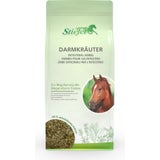 5.0 (12)
5.0 (12)Stiefel Intestinal Herbs, 1 kg
Bestseller- 100% natural herbal mixture
- For digestive problems
- To regulate the gastrointestinal tract
£21.49 (£21.49 / kg)Delivery by May 05
-
 4.8 (9)
4.8 (9)Stiefel Devil´s Claw, Chopped, 1 kg
Bestseller- Good for joints & tendons
- Chopped roots
- Can have a positive effect on the musculoskeletal system
£26.23 (£26.23 / kg)Delivery by May 05
-
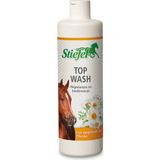 £8.68 (£17.36 / l)
£8.68 (£17.36 / l)Delivery by May 05
-
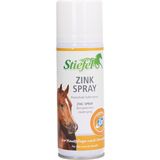 £9.56 (£47.80 / l)
£9.56 (£47.80 / l)Delivery by May 05
-
Great Britain: Free standard delivery from £79.90
-
Free
returns Secure payments
with SSL encryption technology
